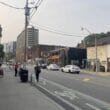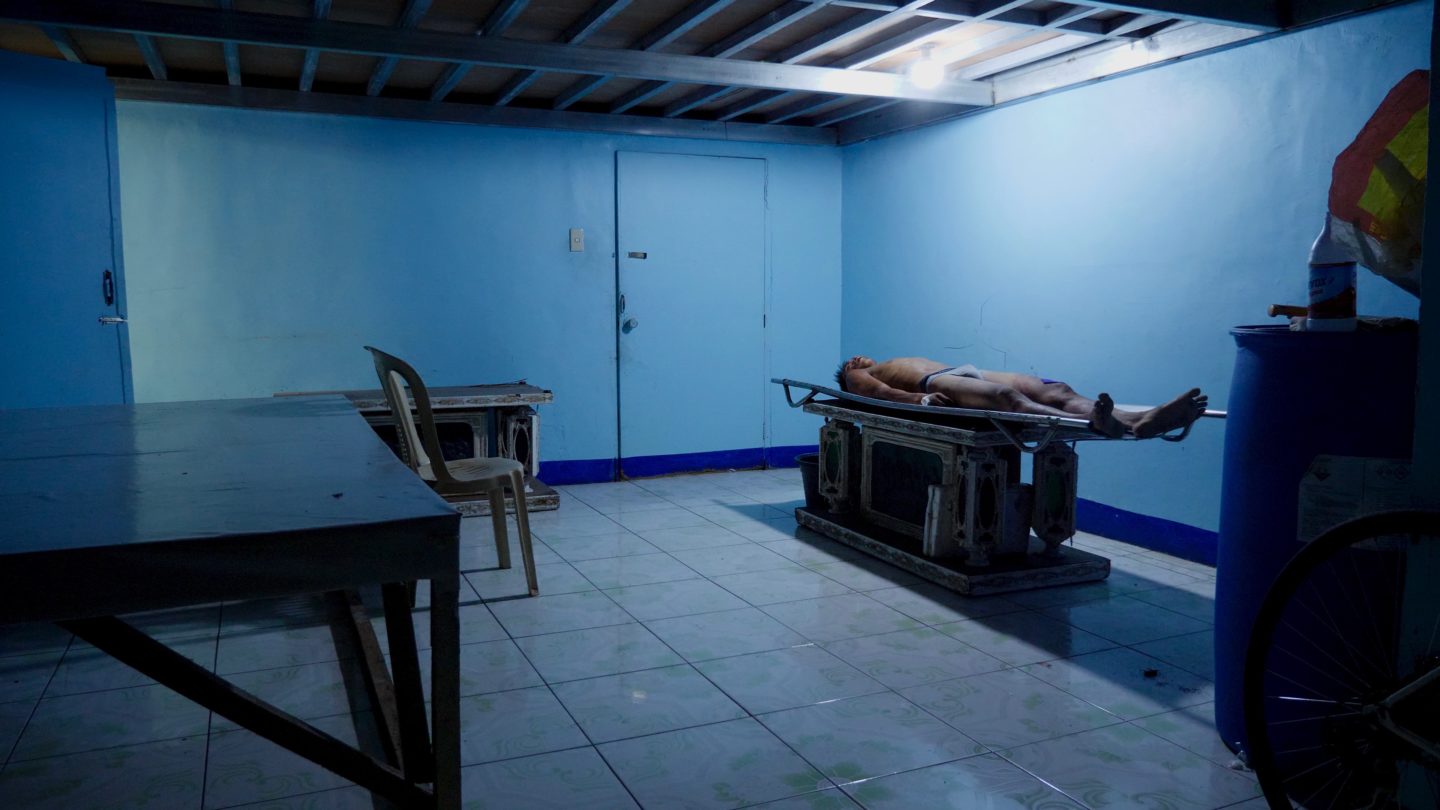The Philippines’ president Rodrigo Duterte was elected in 2016 on a platform of ridding the country of its drug addiction problem.
Under his instruction, thousands of suspected drug users and dealers have been killed by police, with many more live taken by vigilantes after he urged members of the public to kill those involved in drugs and criminality in the country. To date, an estimated 12,000 have lost their lives.
Journalist and filmmaker Anders Palm Olesen visited the capital city, Manila, in 2017, to speak to some of those affected by Duterte’s ruthless drug war.
The Caretakers
They shot him in the foot before he could run. He was pleading, begging for his life. People gathered, silent gazes. It was evident they had gotten the wrong man yet no one seemed to move. The killer looked down at Michael Siaron.
“Oh, you don’t want to run?”
His grave rests on the wall with all the others. Duterte Compound they call it. The first part of the grave complex is already full but the caretakers at Pasay City Cemetery are working hard to finish a new five-story high construction. When it’s ready, it will host another 200 graves.
Since Rodrigo Roa Duterte started his presidential term over two year ago, more than 12,000 people have been killed in Tokhang, the so-called war on drugs. The victims have been Manila’s poorest. In Pasay City Cemetery, the sweet rotten smell surges with the tropic afternoon rains.
Rex “Bibi” Guial, 33, lived all his life in the cemetery and works as a caretaker. In a charming wooden house resting on tall concrete graves, he lives with his wife, Mary Ann, and their youngest daughters. Every morning, they have breakfast on the porch overlooking the cemetery before Bibi gets up to feed the ducks and Mary Ann sends the girls off to school.
For Bibi and his family, Tokhang changed everything. “We wouldn’t go out at night. The houses were closed at seven o’clock. Then they would be ready to come in.”
By “they”, Bibi refers to police and vigilante death squads. The official and independent numbers defer on the actual death toll but roughly one third of the killings are done by police officers – the rest by vigilante groups. “If you are mistaken, there is nothing you can do”.
When Duterte first unleashed Tokhang, policemen would walk around the neighbourhood urging young men to sign a list confirming they were drug addicts and surrendering to a rehabilitation program. Oftentimes, the men wouldn’t know what kind of paper they were signing; either because they couldn’t read – or because the policeman would cover the text with a hand. Now, this list seems to be used to as a “master list”. If the officials have you on that list – you’re suspected drug addict. And then you have reason to fear for your life.
The Mass Grave
“It is right here”, Bibi looks down on the patch of dirt beneath his feet, roughly the size of a garden porch. One of the cemetery’s main dirt paths runs right over. Looking closely, you realize it’s not small stones peeking out of the ground – but human bone. “It was a really deep hole.”
It’s not the only mass grave the caretakers have been digging recently – but it’s the biggest. Twenty-four bodies came in around Spring when the killings were at their peak.
The bodies were collected from the streets before taken to a funeral home – where some had been lying for two months without cooling. This is the fate of Tokhang’s poorest victims.
Many families in Manila’s slum can’t afford funeral costs and don’t collect the deceased. ‘Pauper’, they call them, the unidentified John Doe’s. Instead of a traditional burial, they end up in mass graves on an unmarked patch of dirt.
One of the caretakers and Bibi’s cousin, Edward “Wadwad” Guial, recalls that by the time the corpses came to the cemetery, they were already decomposing. While he and the other caretakers were paid by the number of heads buried, the smell of decay would linger in their clothes and nostrils for days.
A few weeks later, a family from the neighbourhood approached Wadwad. Their son had gone missing and they thought he might be among the 24. There was nothing to do but to reopen the grave; what met him was something that looked like “stew”.
“It was second to last, so we had to dig it again… I couldn’t bear it anymore.”
Down at the bottom of the grave, Wadwad found the remains of the family’s son.
The Preacher
December 2016. Jun Santiago recalls the first time he went out on the night beat in the Manila Police District. It was late in the evening when they arrived at the crime scene.
A dark alley in Metro Manila only lit by flickering Christmas light. The smell of blood hung in the air with the silent fear of people around him. Everyone held their breath. Once the police left, the alley exhaled and echoed with cries over a lost neighbour, father, friend.
Jun Santiago is a Redemptorist Brother and activist. His church, the Redemptorist Church of Baclaran, became a sanctuary and shelter for the victims of the ongoing war on drugs. As an activist, he is part of the so called “night crawlers”, a group of photo-journalists working to document the night time killings in Manila.
Methamphetamine, or “shabu” as it is known locally, has been the main target of Duterte’s war on drugs.
According to the UN Office on Drugs and Crime, there are 1.8 million drug users in the Philippines out of which roughly half – or 0.9 per cent of the population – is accounted for by meth.
The meth users, according to Duterte, become a zombie-like dehumanized individual: “You must remember that those who are already (using) shabu for almost one year, they are dead. They are the living walking dead… They are of no use to society anymore.”
But the problem of methamphetamine isn’t unique to the Philippines and the numbers even start to look small when compared to Australia where meth use amounts to 1.4 per cent of the population.
To Jun Santiago, Tokhang reflects a larger delusion prevalent in the population at large: “many may say that it’s okay for them to die, they are the plagues, they are the rapists, they are the ones who rape babies.” But what he sees happening is a sort of witch hunt; the victims are the poor, the unemployed, the uneducated – mainly from Manila’s urban poor areas.
“It’s scary,” he says, “the law is no longer concerned about the people. The law is on the side of the corrupt police – the ones who were supposed to protect us.”
The population at large has continued to show support for Duterte’s presidency albeit a recent decline in urban areas.
Jun Santiago hopes the Philippines will open their eyes to the atrocities done before them: “The cure is not eliminating the users or the pushers. Too many people have died in the past year without addressing the issue of poverty or corruption.”
The Vigil
The brutal reality for Manila’s poorest is that there is no way of knowing when the killings will end. So far it has lasted for more than two years, and was ‘re-launched’ in February.
The latest Human Rights Watch estimate of those who have lost their lives in the purge is 12,000 killings, while an opposition senator in the country claims 20,000 are dead.
The International Criminal Court (ICC) launched a crimes against humanity inquiry against Duterte in February. In response, he gave notice that The Phillipines would withdraw from the body.
But why is this happening? What sort of incentive would encourage a continued slaughter of his own people? Part of the answer could be that Duterte is so wrapped up in his own narrative that he is no longer capable of untangling himself.
During the election, he hired Nic Gabunada, a marketing consultant, and gave him a budget of $200.000 to assemble a network of internet trolls. He consistently portrayed himself as a no-bullshit patriarch with the muscle and backbone to “do the dirty job”.
Once and for all, he would clean the streets of Manila from crime and corruption. Only then would the Philippines become a prosperous nation.
Echoing Vladimir Putin’s Russia, this has since expanded to a “keyboard army” with thousands of supporters working day-in day-out to amplify Duterte’s narratives and silence opponents.
Control over media and the political narrative means power: The fabrication of fake news in a poorly educated democracy like the Philippines, even more so. Increasingly, it seems like a Pandora’s Box has been opened – and it’s unlikely Duterte will be able to dig out of the authoritarian trenches he summoned around himself.
All the above is a faint whisper to Bibi and the caretakers working at the cemetery. Their future is bound to the earth beneath their feet: “The holes are filled right away… Who is next? It will not leave our minds when building the graves; we can be the ones to end up here.”
Bibi sees no immediate way out of the ghastly void: “We won’t find peace until Duterte’s term ends. That’s it”.
All videos and images by Anders Palm Olesen, except President Duterte meeting President Putin, which is in the Public Domain.














